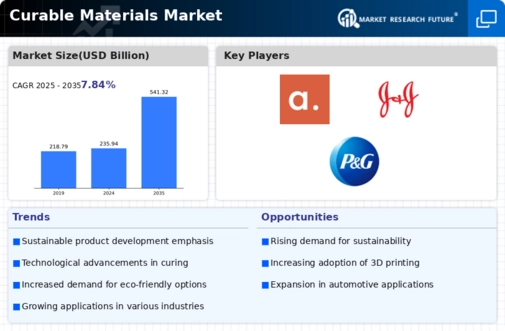Market Trends
Key Emerging Trends in the Curable Materials Market
The present period has seen interesting conception currents in Curable Materials markets which reflect along with the dynamics of such industries as electronics, coatings and medical devices. Curable materials including UV-curable, thermal-curable and electron-beam-curable formulations have experienced significant dynamism in terms of demand patterns and applications across various sectors.
One notable current is the increased utilization of curable materials in the electronics industry. This kind of material is used when making electronic components like circuit boards, including displays that require quick drying and accurate control over material properties. Hence, smaller and complex devices continue being developed within the electronics sector leading to an increasing demand for curable materials which are critical for effective manufacturing processes and high-performance electronic products.
Beside this, there has been growing interest in curable materials within the coatings industry. Compared to conventional solvent-based alternatives UV-curable coatings are becoming more popular due to their fast curing time alongside low environmental footprinting qualities brought about by lessening volatile organic compounds (VOC). Such industries like automotive production line furniture building sector or packing companies are incorporating cure able coating because it tends to boost efficiency through lowering energy consumption as well meet restrictive environmental norms. The future will see a greater reliance on curable materials as sustainability becomes a key driver in coating formulations because they contain lower amounts of VOC’s (volatile organic compound) and can be cured more efficiently using less energy.
Further still, there are innovations happening in Curable Materials market regarding formulations that are meant to address specific industry requirements. Manufacturers are investing more in R&D to develop curable materials with modified properties such as improved flexibility, adhesion and resistance against various environmental conditions. This is prompted by the need for all-purpose curable materials that will cater for varying challenges faced by different industries while ensuring high performance and sustainability.
This way, the Curable Materials market has been experiencing technological advancements through innovations in curing methods and application techniques geared towards enhancing operational efficiency and minimizing environmental repercussions. As a result, manufacturers have been exploring cutting edge curing technologies, sustainable sourcing of raw materials, as well as coming up with improved performance oriented curables. Such a trend coincides with an industry-wide effort at adopting green chemistry approach and sustainable practices within chemical manufacturing.






Leave a Comment